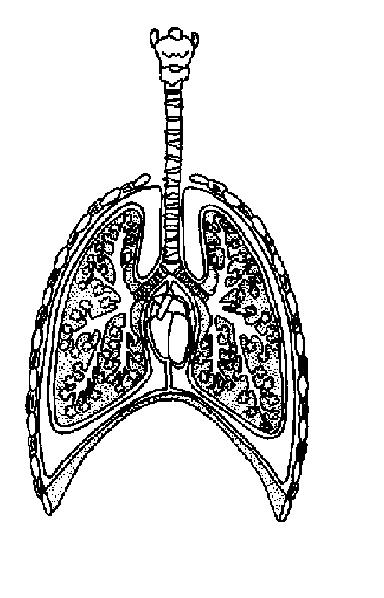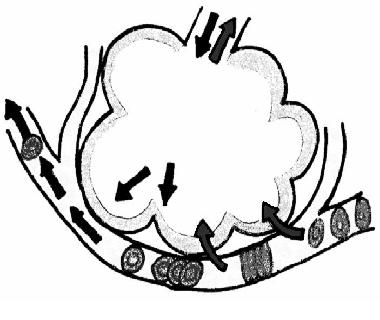The Anatomy and Physiology of Animals/Respiratory System Worksheet
1. Add the following labels to the diagram of the respiratory system of a dog below:
- trachea; bronchioles; diaphragm; bronchi; ribs; larynx; pleural membranes;
- pleural cavity; rings of cartilage around trachea; alveoli.
2. List the structures below in the order in which air passes them as it travels from the nose to the lungs
- alveoli; trachea; bronchi; bronchioles; larynx; pharynx.
3. Which is the odd one out?
- trachea; oesophagus; nasal cavity; larynx; bronchi; bronchioles
4. How are dust particles that enter the respiratory system in the air expelled?
5. Add the correct terms from the list below to the following descriptions.
- A. Alveoli; B. Trachea; C. Bronchioles; D. Palate; E. Pleura; F. Diaphragm;
- G. Pharynx; H. Expiration; I. Epiglottis; J. Tidal volume.
- a) Smallest respiratory passageways.
- b) Separates the mouth from the nose.
- d) Windpipe.
- e) Where gas exchange takes place.
- f) Stops food “going the wrong way” ie choking during swallowing.
- g) Both air and food pass through this.
- h) The movement of air out of the lungs.
- i) The main muscle involved in inspiration.
- j) Membranes that cover the lungs and line the pleural cavity.
- k) The volume of air inhaled or exhaled at each normal breath.
6. Arrange these statements in the right order to describe inspiration.
- A. The air pressure in the air tight pleural cavities decreases
- B. The muscles between the ribs contract to move the ribs cranially and laterally
- C. Air is drawn down the trachea into the lungs
- D. The diaphragm contracts and flattens
- E. The lungs expand to fill the space created
7. True or false?
- a) The pericardium is the membrane surrounding the lungs. T / F
- b) The tidal volume describes the maximum amount of air that can be inhaled into the lungs. T / F
- c) Tidal volume can be measured with a peak flow meter T / F
- d) Inspiration takes up energy but expiration (during normal at rest breathing) is a passive process not normally requiring energy. T / F
- e) The diaphragm is made of smooth muscle. T / F
- f) The epiglottis closes off the larynx during swallowing. T / F
- g) The rate of breathing is controlled by the pituitary gland. T / F
- h) When an animal exercises the rate of breathing increases because the carbon dioxide in the blood increases. T / F
- i) Carbon dioxide dissolved in the blood makes the blood alkaline. T / F
- j) Carbon dioxide in the blood is mainly carried in the blood plasma.T / F
- k) Oxygen moves from the alveoli into the capillaries by the process of osmosis. T / F
- l) Expired air contains about 16% oxygen. T / F
8. Add the following labels to the diagram of a section cut across lung alveoli shown below.
- alveoli; thin layer of water; area of high oxygen concentration; area of high carbon dioxide concentration;
- movement of oxygen; movement of carbon dioxide; air flowing in and out of alveoli; blood flowing along capillary.
9. Which of the statements below gives the best definition of gas exchange?
- a) swapping oxygen for digested food in the gut capillaries.
- b) using energy to breathe.
- c) exchanging inhaled air for exhaled air in the lungs.
- d) exchanging oxygen for carbon dioxide in the lung alveoli.
10. Which of the following help the lungs to be such good gas exchange organs? (Choose at least 4).
- They are close to the heart.
- They are surrounded by pleural membranes.
- They have a large surface area.
- The air in the alveoli and blood in the capillaries are separated by a 2 very thin layers of cells.
- The blood flows more slowly in the lung capillaries as they are so narrow.
- The haemoglobin carries lots of oxygen.
- Breathing constantly changes the air in the alveoli.
- Active transport increases the rate at which the two gases move.
11. Add the terms from the list below to the blanks in the following statements.
- Active transport ; B. Air of the alveoli to the capillary blood; C. Carbon dioxide -poor and oxygen –rich; D. Capillary blood to alveolar air; E. Capillary blood to tissue cells; F. Diffusion; G. Higher concentration; H. Lower concentration; I. Oxygen-poor and carbon dioxide – rich; J. Tissue cells to capillary blood.
Gas exchange takes place bt the process of (1) .............…
When substances move in this way, they pass from areas of (2) ................. to areas of their (3).................
Thus in the alveoli of the lungs oxygen continually passes from the (4)................ and then in the tissues from the (5).................
Conversely in the tissues carbon dioxide moves from the(6)................. and in the lungs from (7)...................
From the lungs it passes out of the body during expiration. As a result of gas exchange, the blood in (most) arteries tends to be (8).................. while the blood in (most) veins is (9) ...................

